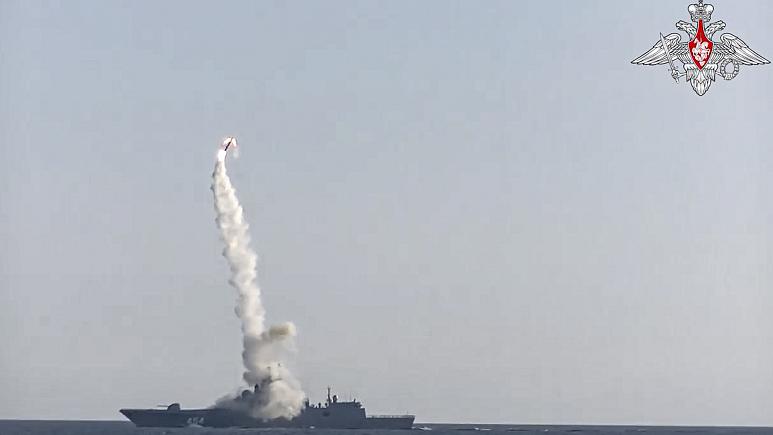The US, the world’s largest and most technologically advanced military, has over the last few years has been losing its edge to Russia and China. Both exploited its political decline and politico-economic contradictions that have had a bearing on its military advantage to catch up that has radically altered the military balance.
China’s New BVR Missile Attached To J-20 Stealth Jets Promises To End US Air Dominance
World’s Two Heavy-Duty Fighter Jets – Su-30MKI & F-15 Eagle – Prepare For ‘Aerial Faceoff’ Later This Year?
Hypersonic missiles are one category that Washington is missing, where one of the prototypes failed in a July 28 test. This was an AGM-183A Air-Launched Rapid Response Weapon (ARRW). The US finally got a breakthrough though, quite recently.
Russia and China have inducted fully operational hypersonic systems, with the former having three staggeringly fast missiles that can fly close to Mach 9 (nine times the speed of sound).
Today, Russia’s Project 885 Yasen nuclear submarine Severodvinsk carried out the first-ever underwater launch of the Zircon hypersonic missile, the defense ministry said. Earlier, Severodvinsk carried out the first-ever on-surface firing.
“The crew of the Severodvinsk nuclear-powered missile cruiser submarine successfully completed the second test launch of the Zircon hypersonic missile. The second test-firing was carried out by the Severodvinsk crew from a submerged position for the first time, from a depth of 40 meters [131 feet] in the White Sea waters, at a conditional target in the Barents Sea,” the Russian Defense Ministry said in a statement.
After ‘Breakthrough’ Rafale Deal, Five Reasons Why India Could Now Procure Nuclear Submarines From France
The Avangard surface-launched missile, Kinzhal air-launched hypersonic cruise missile, and the Tsirkon 3M22 anti-ship hypersonic missile took the world by storm when they were revealed in 2018 and the recent test only adds to its stature.
Videos of their tests and admissions by US experts and military leaders themselves of their complete superiority over any American or Western missile defense system sent the US defense establishment in a tizzy.

China too has been pointed to have an absolute advantage in the South China Sea (SCS) with its ultra-long-range YJ-18 Anti-Ship Cruise Missiles (540 km), PL-15 Beyond Visual Range missile (300 km) that outranges every US missile of the class.
This is besides the completely unorthodox DF-21D Anti-Ship Ballistic Missile (ASBM). Its DF-17 medium-range ballistic missile revealed in October 2019 too releases the DF-ZF hypersonic glide vehicle.
AI-Enabled Command & Control System
Russia has set in motion the operationalization of an automated command and control system of its Tsirkon (also spelled as Zircon) missile that is being seen as Moscow’s own version of a networked battlespace.
F-22 Pilot Explains Why His ‘Super Lethal’ Fighter Jet Will Avoid An Aerial Duel With Russian Su-35 Aircraft
The evolution in network-centric warfare was marked by China with its ‘Intelligenized Warfare’. However, details emerging out of an August 27 test of the Tsirkon by the Northern Fleet have revealed the employment of the unique Avtomatizirovannoy Systemi Upravleniya (ASU).
The Tsirkon flies close to 10,000 km an hour, at ranges of nearly a hundred kilometers, at altitudes 30-40 kilometers from the sea level where the air resistance is low and carries 450 kg warhead.
The test involved the integration of this Command and Control (C&C), the naval ASU, and the Tsirkon hypersonic missile. The ASU combined aviation and maritime assets including the nuclear submarine Orel, cruiser Marshal Ustinov and frigate Admiral of the Fleet Kasatanov, two crews of the Tu-142 reconnaissance aircraft, and anti-submarine aircraft. They transmitted data to the C&C that employed Intelligence Surveillance and Reconnaissance (ISR) with the ASU, which “independently identified” the “most important” target, acquired the target, and executed the strike.
They transmitted data to the C&C that employed Intelligence Surveillance and Reconnaissance (ISR) with the ASU, which “independently identified” the “most important” target, acquired the target, and executed the strike.
Unnerved By Chinese Military Tech, US Air Force Moots Turning Its ‘Flying Mammoth’ Into Hypersonic Missile Platform
Besides aircraft, the ASU also received data from ground-based radars, satellites, and drones, where this enhancement in the speed of decision-making is believed to have been achieved by Artificial Intelligence (AI).

Russia’s first Pion-NKS active radar reconnaissance satellite of the Liana system launched on June 25 this year observes military and civilian ships throughout the day under all-weather conditions. The Lotos-C1 satellites, also part of the Liana system, monitors radio signals of warships.
US Achieves Big Breakthrough In Hypersonic Missile Technology After Back-To-Back Failures
This ASU can also be fused with other precision strike systems like the Kalibr, Vulkan, Yakhont, P-800 Onyx, with the Tsirkon being capable from the same launchers of the Kalibr and Onyx. These missiles can be launched from smaller missile ships like the Buyan-M and Karakrut, thus even making them capable of firing the Tsirkon ‘carrier killing’ hypersonic missile.
The quick reaction and decision on enemy assets, from distances hundreds of kilometers by utilizing the sheer speed and range of the missile from a variety of existing platforms, is the hallmark of the system and the missile according to Russia’s defense ministry officials.
The US Acknowledged Russian Capability
In mid-August, US Strategic Command Chief Charles Richard, speaking at the annual symposium on space defense, acknowledged that Russian hypersonic technology will provide the Russian Navy with an undeniable advantage.
US Approves First Overseas Squadron Of F-35A Jets; F-35Bs Get Clearance To Operate From Japanese Carrier
“Our current ground-based and space-based sensor system may not be able to cope with the detection and tracking of these missiles. I must admit that Russia is the world’s leading country in hypersonic technology. And if the enterprises of our defense industry in a short time do not figure out how to resist them, the ships of the fleets of the NATO countries will become vulnerable,” Richard said.
Russia plans to even go a step further, transitioning from single launches at coastal ranges, to firing salvos. That the test was conducted before the subsequent Zapad 2021 exercises with Belarus between September 10 and 16 (also called ‘combined strategic exercise’) gave context to the military maneuvers.
Russia now plans to develop a fourth hypersonic missile called Kh-95 to be launched from the Tupolev Tu-22 M3M long-range strategic bomber as was reported by EurAsian Times. It will now have the largest range of hypersonic missiles with the greatest flexibility and fine-tuned techno-industrial systems to support them.
- Parth Satam is a Mumbai-based journalist who has been covering India’s defense sector for more than a decade. He maintains a keen interest in defense, aerospace and foreign affairs and can be reached at satamp@gmail.com
- Follow EurAsian Times on Google News




